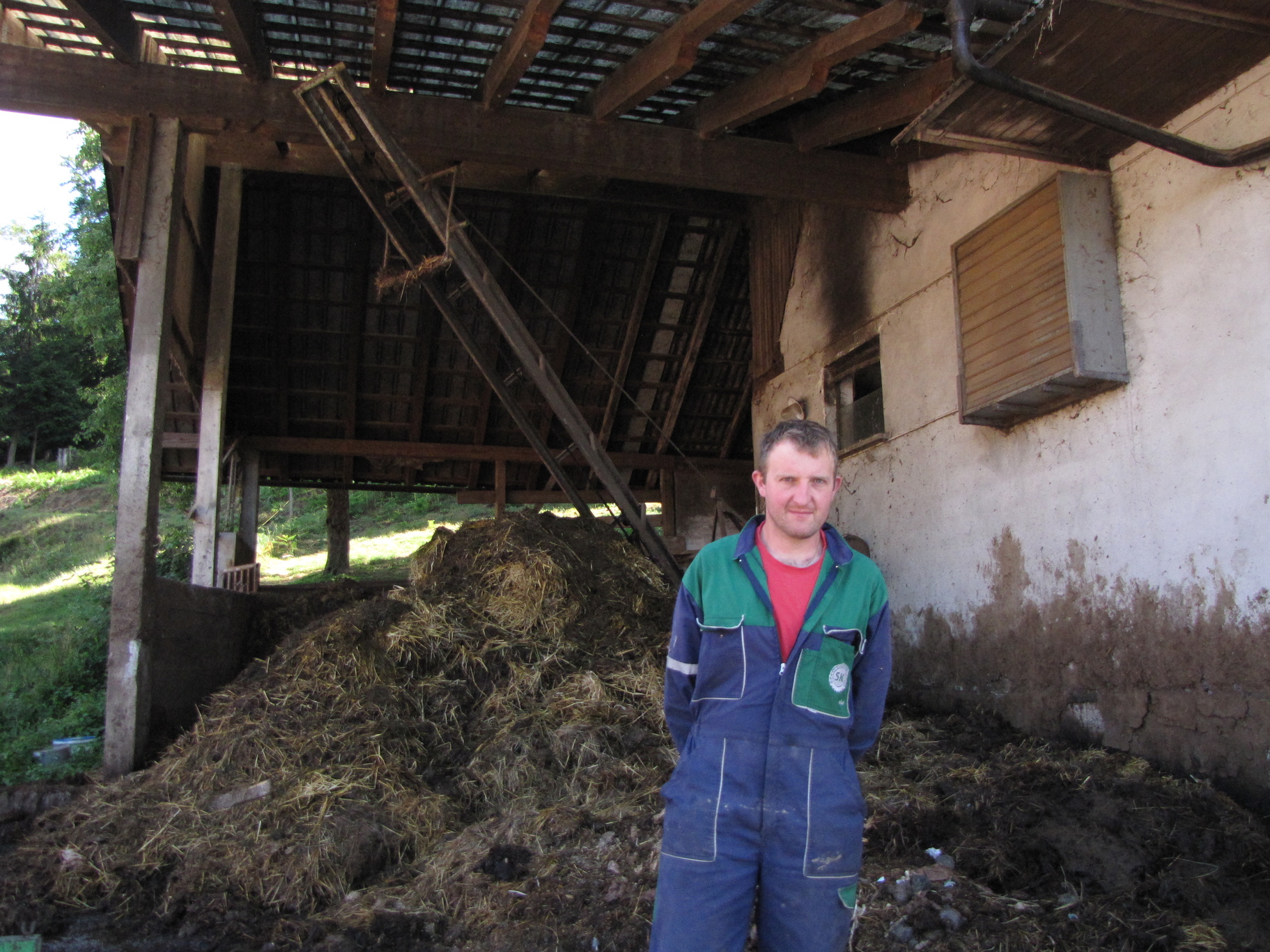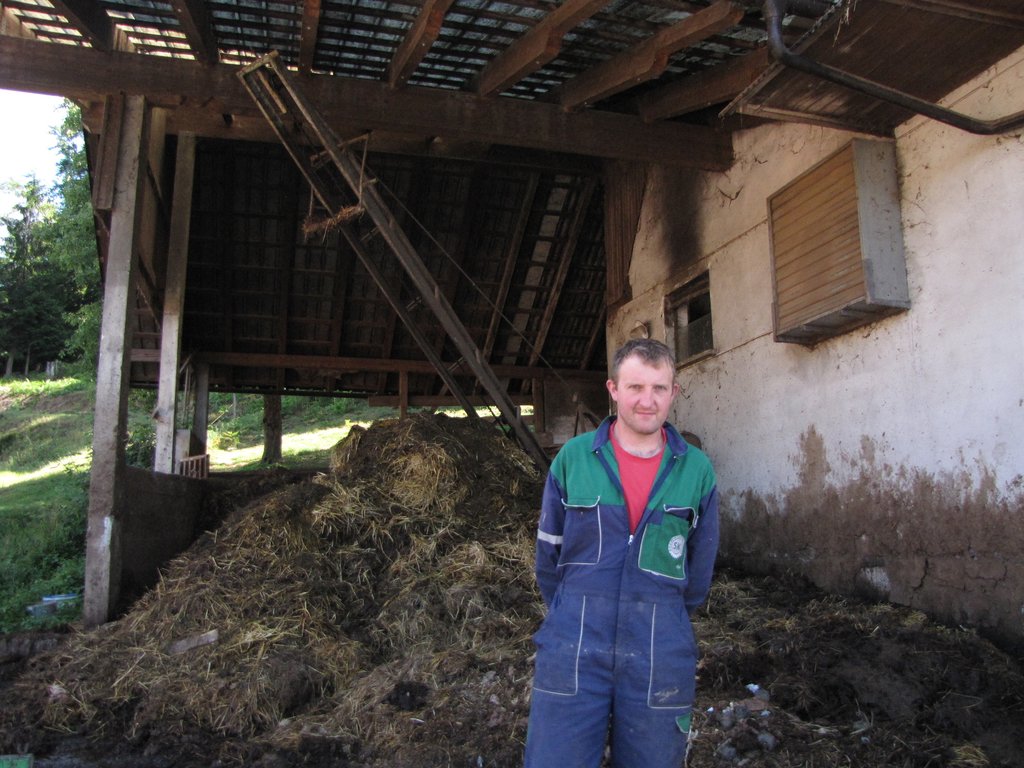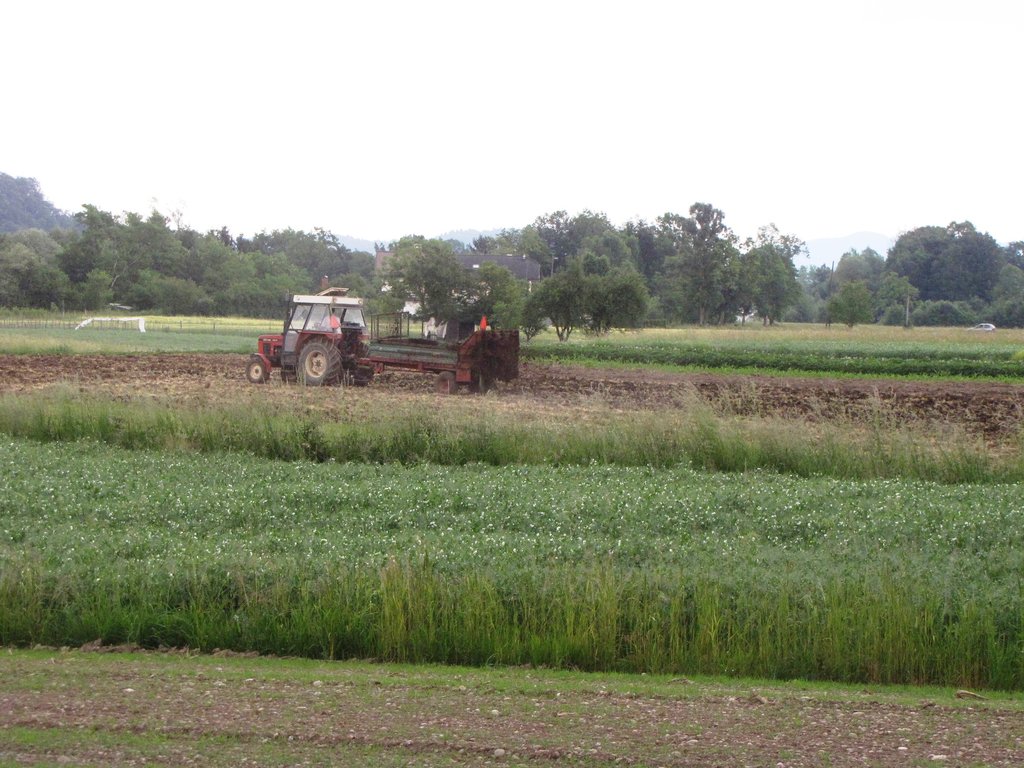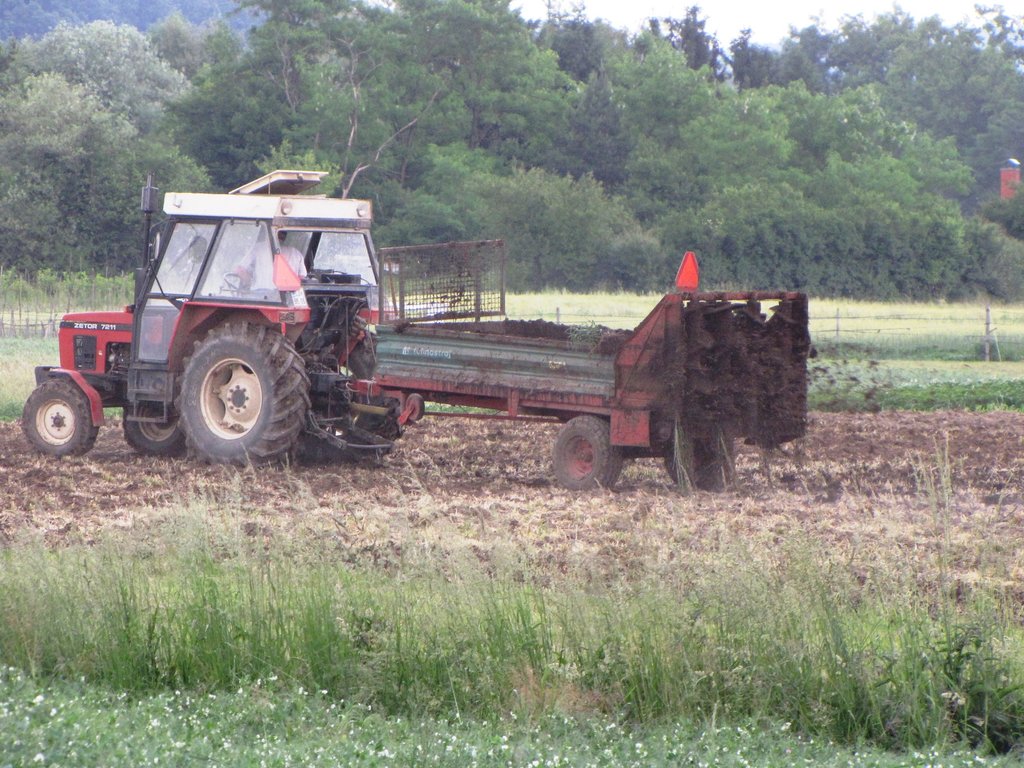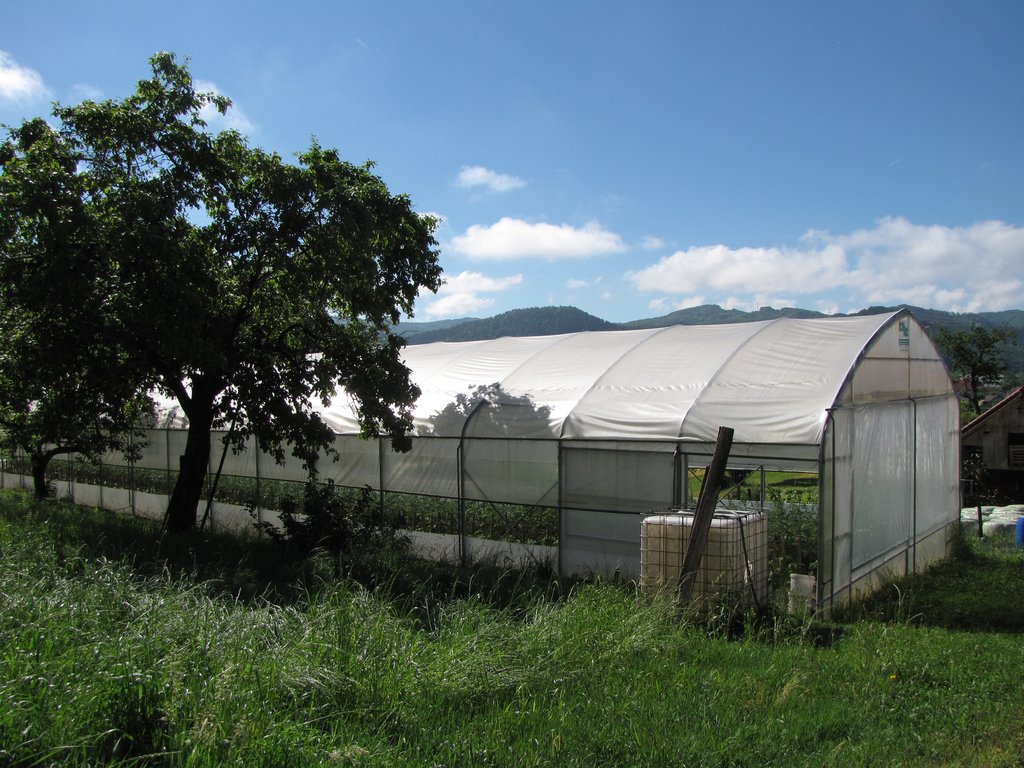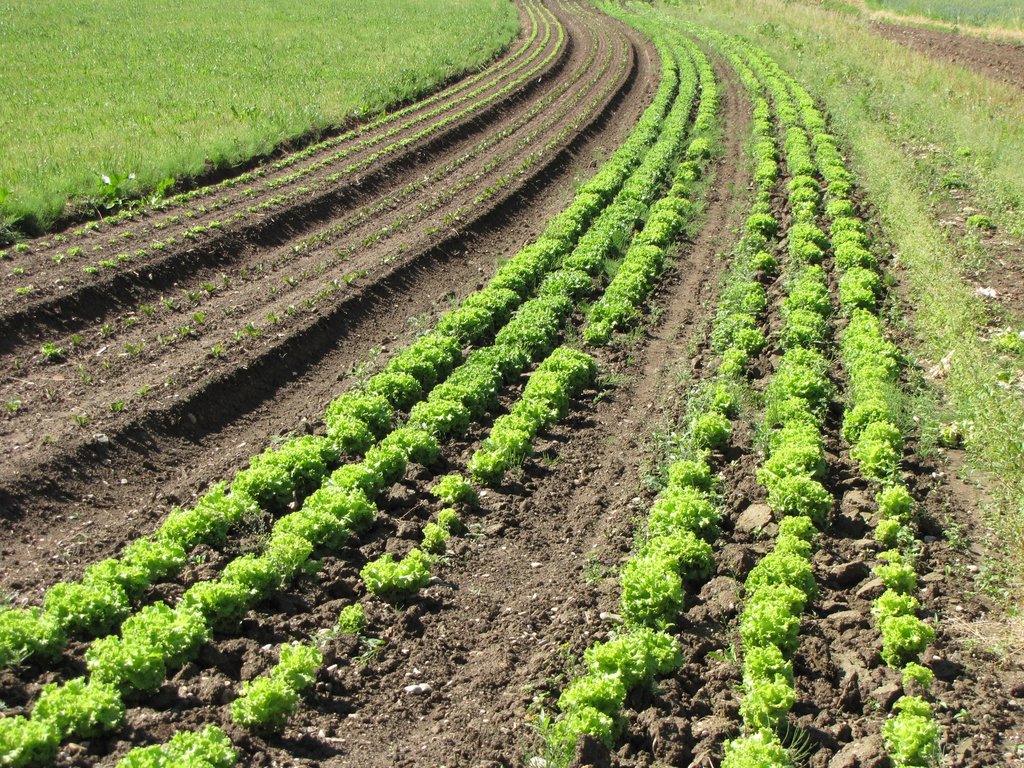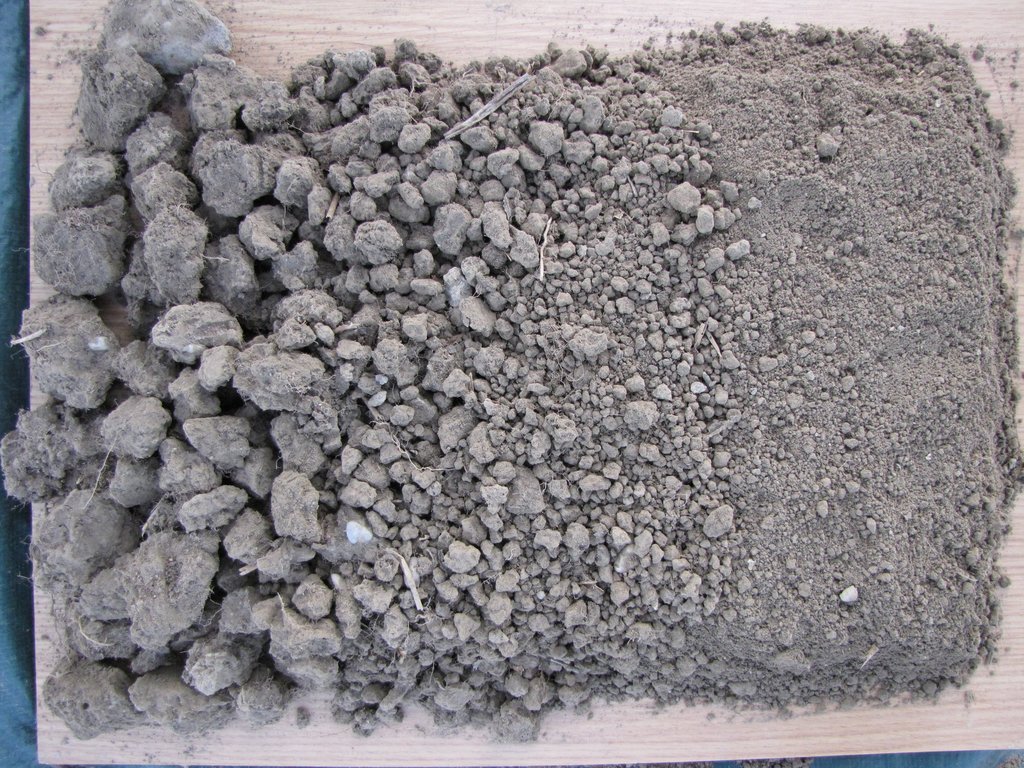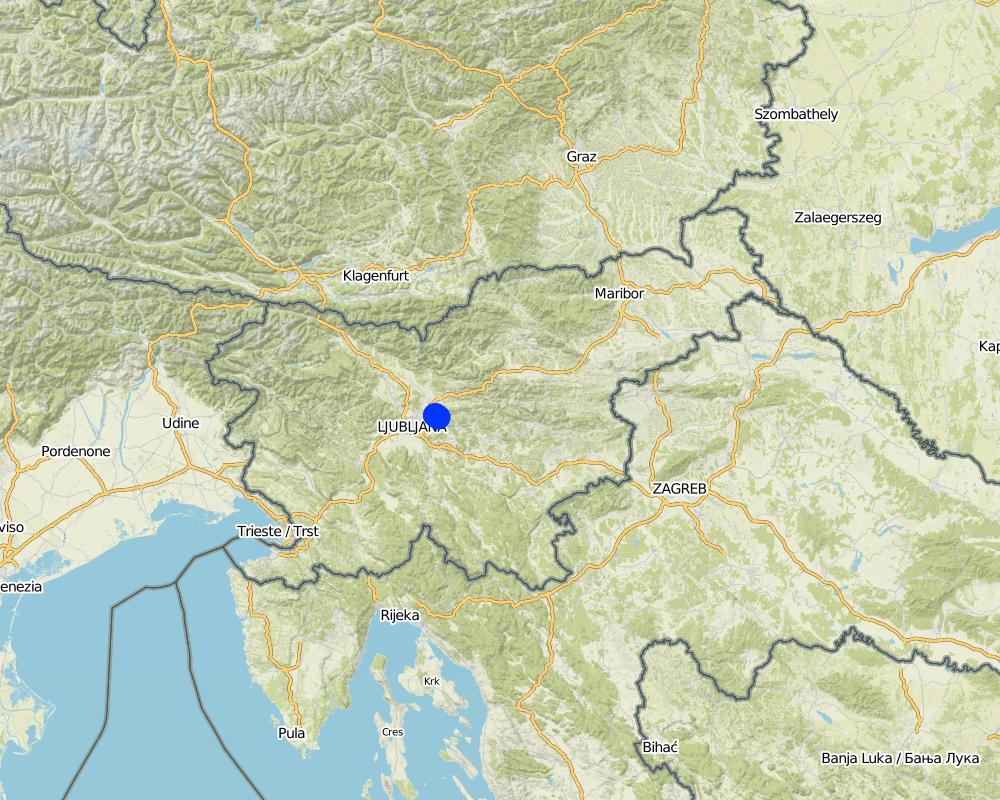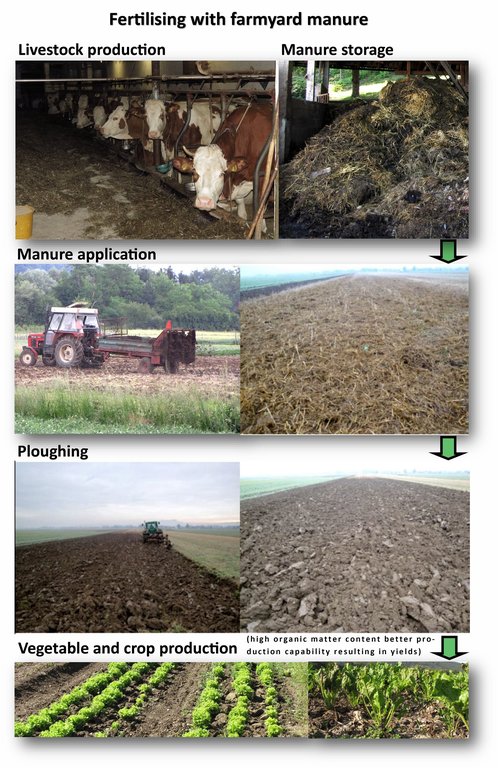Fertilising with farmyard manure [斯洛文尼亚]
- 创建:
- 更新:
- 编制者: Matjaz Glavan
- 编辑者: –
- 审查者: Ursula Gaemperli, Gudrun Schwilch
Gnojenje s hlevskim gnojem
technologies_2824 - 斯洛文尼亚
查看章节
全部展开 全部收起1. 一般信息
1.2 参与该技术评估和文件编制的资源人员和机构的联系方式
有助于对技术进行记录/评估的项目名称(如相关)
Interactive Soil Quality assessment in Europe and China for Agricultural productivity and Environmental Resilience (EU-iSQAPER)有助于对技术进行记录/评估的机构名称(如相关)
Department for Agronomy, University of Ljubljana - 斯洛文尼亚1.3 关于使用通过WOCAT记录的数据的条件
(现场)数据是什么时候汇编的?:
09/06/2017
编制者和关键资源人员接受有关使用通过WOCAT记录数据的条件。:
是
1.4 所述技术的可持续性声明
这里所描述的技术在土地退化方面是否存在问题,导致无法被认为是一种可持续的土地管理技术?:
否
2. SLM技术的说明
2.1 技术简介
技术定义:
The technology is based on use of livestock manure from dairy cows (excreta and cereals straw) for fertilisation of arable fields with 3-5 year rotation. Manure has a very good effect on soil production capacity and on growth of vegetable crops.
2.2 技术的详细说明
说明:
1. The technology is applied in the flatlands of Ljubljana with an average altitude of 350 m.a.s.l. Average annual precipitation is 1400 mm. The area is characterized with often stormy precipitation events and occasional droughts. Silty loam soils in the area are moderately deep to deep with medium soil organic matter. Area has good availability of surface water and groundwater of good drinking quality. The biodiversity of the area is medium without any salinity and flooding problems. Sedentary agriculture with mixed or commercial agriculture is practiced with less than 10% of income coming from off-farm activities. The examined farm household has an average wealth and is fully mechanized/motorized. All farm households have a good access to services and infrastructure. The examinded farm is medium in scale with land patly owned by the land user and partly leased from other private owners.
2. Main characteristic is the use of livestock manure on arable fields and especially for vegetable production. Manure is composed from solid dairy cows excreta and cereals straw (wheat, barley) which is used as bedding for cows. Manure is composted for few months (4-6, depends on storage capacity). It is spread before ploughing and then ploughed into the soil. Spreading of manure is done in autumn or in spring. Knowledge on time of spreading and on handling with machines is needed.
3. Main function is increasing organic matter in the soil and also all major nutrients (nitrogen, phosphorus, potassium, magnesium, calcium etc.). This leads to better (1) productivity due to nutrients slow release, (2) better water holding capacity and (3) decreased soil compaction threat.
4. Major inputs needed to establish are: livestock (animals), stable adapted to the manure collection, use of straw bedding, storage facility (if possible covered with roof), manure spreader, and loading equipment. Major inputs to maintain are: keeping of the livestock herd and maintenance of the machines.
5. The benefits are: (1) increase in soil organic matter, (2) increase soil water holding capacity, (3) to maintain soil productivity, (4) increase in yields quantity and quality.
6. Land users like: (1) lower cost for mineral fertilisers, (2) impact on soil fertility, (3) it's a traditional method.
Land users dislike: (1) time-consuming - labour hours invested, (2) storage capacity takes space, (3) costs of transport.
2.3 技术照片
2.4 技术视频
注释、简短说明:
.
2.5 已应用该技术的、本评估所涵盖的国家/地区/地点
国家:
斯洛文尼亚
有关地点的进一步说明:
Municipality of Dol pri Ljubljani
Map
×2.6 实施日期
如果不知道确切的年份,请说明大概的日期:
- 50多年前(传统)
2.7 技术介绍
详细说明该技术是如何引入的:
- 作为传统系统的一部分(> 50 年)
3. SLM技术的分类
3.1 该技术的主要目的
- 改良生产
- 减少、预防、恢复土地退化
- 创造有益的经济影响
3.2 应用该技术的当前土地利用类型

农田
- 一年一作
主要农作物(经济作物及粮食作物):
silage maize / winter barley / winter wheat / vegetable / potatoe / sugar beet
3.3 有关土地利用的更多信息
该技术所应用土地的供水:
- 雨养
注释:
only vegetables are also irrigated
每年的生长季节数:
- 1
具体说明:
one main crop
3.4 该技术所属的SLM组
- 农畜综合管理
- 土壤肥力综合管理
3.5 技术传播
具体说明该技术的分布:
- 均匀地分布在一个区域
如果该技术均匀地分布在一个区域上,请注明覆盖的大致区域。:
- 0.1-1 平方千米
3.6 包含该技术的可持续土地管理措施

农艺措施
- A2:有机质/土壤肥力

结构措施
- S11:其它

管理措施
- M7:其它
3.7 该技术强调的主要土地退化类型

化学性土壤退化
- Cn:肥力下降和有机质含量下降(非侵蚀所致)

物理性土壤退化
- Pc:压实
- Pk:熟化和结壳

生物性退化
- Bq:数量/生物量减少
- Bl:土壤寿命损失
3.8 防止、减少或恢复土地退化
具体数量名该技术与土地退化有关的目标:
- 防止土地退化
- 减少土地退化
4. 技术规范、实施活动、投入和成本
4.1 该技术的技术图纸
4.2 技术规范/技术图纸说明
The infographic presents main parts of the technology from livestock originated manure, stored and composted and finally applied over fields. After that manure is incorporated in to the soil with purpose of improving the productivity of soils and for better crop and vegetable yields.
4.3 有关投入和成本计算的一般信息
具体说明成本和投入是如何计算的:
- 每个技术区域
注明尺寸和面积单位:
28 hectares
其它/国家货币(具体说明):
EUR (€)
注明美元与当地货币的汇率(如相关):1美元=:
0.89
注明雇用劳工的每日平均工资成本:
50 EUR
4.4 技术建立活动
| 活动 | 措施类型 | 时间 | |
|---|---|---|---|
| 1. | construction of the storage facility for capacity of 6 month | 结构性的 | all year around |
| 2. | Purchase of machinery for manure loading | 管理 | all year around |
| 3. | Purchase of machinery for manure transport | 管理 | all year around |
注释:
However, this is a traditional method, so farmer has mainly maintenance costs.
4.5 技术建立所需要的费用和投入
如果可能,按下表分列技术建立费用,并列明各项投入和每项投入的费用。如果您无法分解成本,给出建立该技术的总成本估算。:
2.0
| 对投入进行具体说明 | 单位 | 数量 | 单位成本 | 每项投入的总成本 | 土地使用者承担的成本% | |
|---|---|---|---|---|---|---|
| 设备 | Storage facililty for 6 month capacity | pcs | 1.0 | 10000.0 | 10000.0 | 100.0 |
| 设备 | Machine for loading manure | pcs | 1.0 | 10000.0 | 10000.0 | 100.0 |
| 设备 | Machine for transport of manure | pcs | 1.0 | 15000.0 | 15000.0 | 100.0 |
| 技术建立所需总成本 | 35000.0 | |||||
4.6 维护/经常性活动
| 活动 | 措施类型 | 时间/频率 | |
|---|---|---|---|
| 1. | Labour with daily manure handling | 农业学的 | all year around |
| 2. | Labour with transport to the fields | 农业学的 | all year around |
| 3. | Maintanance of machines | 农业学的 | all year around |
4.7 维护/经常性活动所需要的费用和投入(每年)
| 对投入进行具体说明 | 单位 | 数量 | 单位成本 | 每项投入的总成本 | 土地使用者承担的成本% | |
|---|---|---|---|---|---|---|
| 劳动力 | Manure handling every day | EUR/hour | 182.5 | 6.25 | 1140.63 | 100.0 |
| 劳动力 | Transport to the fields | EUR/hour | 30.0 | 6.25 | 187.5 | 100.0 |
| 设备 | Maintanance of machines | EUR/hour | 8.0 | 6.25 | 50.0 | 100.0 |
| 技术维护所需总成本 | 1378.13 | |||||
4.8 影响成本的最重要因素
描述影响成本的最决定性因素:
Labour is the most important. It is followed by livestock herd. However, herd costs are covered with milk production.
5. 自然和人文环境
5.1 气候
年降雨量
- < 250毫米
- 251-500毫米
- 501-750毫米
- 751-1,000毫米
- 1,001-1,500毫米
- 1,501-2,000毫米
- 2,001-3,000毫米
- 3,001-4,000毫米
- > 4,000毫米
指定年平均降雨量(若已知),单位为mm:
1352.00
有关降雨的规范/注释:
Averegae rainfall period (1991-2000).
Majority of rain in autumn, followed by summer, spring and winter.
注明所考虑的参考气象站名称:
Ljubljana - Bežigrad
农业气候带
- 半湿润
Strong summer tunder storms and showers. Local precipitation.
5.2 地形
平均坡度:
- 水平(0-2%)
- 缓降(3-5%)
- 平缓(6-10%)
- 滚坡(11-15%)
- 崎岖(16-30%)
- 陡峭(31-60%)
- 非常陡峭(>60%)
地形:
- 高原/平原
- 山脊
- 山坡
- 山地斜坡
- 麓坡
- 谷底
垂直分布带:
- 0-100 m a.s.l.
- 101-500 m a.s.l.
- 501-1,000 m a.s.l.
- 1,001-1,500 m a.s.l.
- 1,501-2,000 m a.s.l.
- 2,001-2,500 m a.s.l.
- 2,501-3,000 m a.s.l.
- 3,001-4,000 m a.s.l.
- > 4,000 m a.s.l.
说明该技术是否专门应用于:
- 不相关
5.3 土壤
平均土层深度:
- 非常浅(0-20厘米)
- 浅(21-50厘米)
- 中等深度(51-80厘米)
- 深(81-120厘米)
- 非常深(> 120厘米)
土壤质地(表土):
- 粗粒/轻(砂质)
- 中粒(壤土、粉土)
土壤质地(地表以下> 20厘米):
- 中粒(壤土、粉土)
表土有机质:
- 中(1-3%)
5.4 水资源可用性和质量
地下水位表:
5-50米
地表水的可用性:
好
水质(未处理):
良好饮用水
水的盐度有问题吗?:
否
该区域正在发生洪水吗?:
否
5.5 生物多样性
物种多样性:
- 中等
栖息地多样性:
- 中等
5.6 应用该技术的土地使用者的特征
定栖或游牧:
- 定栖的
生产系统的市场定位:
- 混合(生计/商业
非农收入:
- 低于全部收入的10%
相对财富水平:
- 平均水平
个人或集体:
- 个人/家庭
机械化水平:
- 机械化/电动
性别:
- 男人
土地使用者的年龄:
- 中年人
5.7 应用该技术的土地使用者拥有或租用的平均土地面积
- < 0.5 公顷
- 0.5-1 公顷
- 1-2 公顷
- 2-5公顷
- 5-15公顷
- 15-50公顷
- 50-100公顷
- 100-500公顷
- 500-1,000公顷
- 1,000-10,000公顷
- > 10,000公顷
这被认为是小规模、中规模还是大规模的(参照当地实际情况)?:
- 中等规模的
5.8 土地所有权、土地使用权和水使用权
土地所有权:
- 州
- 个人,有命名
土地使用权:
- 租赁
- 个人
用水权:
- 个人
5.9 进入服务和基础设施的通道
健康:
- 贫瘠
- 适度的
- 好
教育:
- 贫瘠
- 适度的
- 好
技术援助:
- 贫瘠
- 适度的
- 好
就业(例如非农):
- 贫瘠
- 适度的
- 好
市场:
- 贫瘠
- 适度的
- 好
能源:
- 贫瘠
- 适度的
- 好
道路和交通:
- 贫瘠
- 适度的
- 好
饮用水和卫生设施:
- 贫瘠
- 适度的
- 好
金融服务:
- 贫瘠
- 适度的
- 好
- 贫瘠
- 适度的
- 好
6. 影响和结论性说明
6.1 该技术的现场影响
社会经济效应
生产
作物生产
作物质量
饲料生产
饲料质量
产品多样性
注释/具体说明:
Organic manure is crucial in vegetable production. The examinded farm would already have stopped the livestock production but then he would lack manure as crucial component for the vegetable production. Few years ago the land user only produced raw milk but as market demand for vegetable increased he started with this type of production.
土地管理
收入和成本
农业投入费用
农业收入
收入来源的多样性
注释/具体说明:
Organic manure is crucial in vegetable production. Few years ago the examined land user only produced raw milk but as the market demand for vegetable increased he started with this type of production too..
工作量
生态影响
土壤
土壤水分
土壤堆积
土壤结壳/密封
土壤压实
养分循环/补给
土壤有机物/地下C
生物多样性:植被、动物
有益物种
减少气候和灾害风险
干旱影响
注释/具体说明:
Farmer observed that soils with regular application of manure have better ability to retain soil moisture, reducing impacts of drought.
6.2 该技术的场外影响已经显现
地下水/河流污染
6.3 技术对渐变气候以及与气候相关的极端情况/灾害的暴露和敏感性(土地使用者认为的极端情况/灾害)
渐变气候
渐变气候
| 季节 | 气候变化/极端天气的类型 | 该技术是如何应对的? | |
|---|---|---|---|
| 季节性温度 | 夏季 | 增加 | 好 |
| 季节性温度 | 秋季 | 增加 | 好 |
| 季雨量 | 夏季 | 减少 | 未知 |
气候有关的极端情况(灾害)
气象灾害
| 该技术是如何应对的? | |
|---|---|
| 局地暴雨 | 未知 |
| 局地雷暴 | 未知 |
| 局地雹灾 | 未知 |
气候灾害
| 该技术是如何应对的? | |
|---|---|
| 热浪 | 好 |
| 寒潮 | 未知 |
| 极端冬季条件 | 未知 |
| 干旱 | 好 |
6.4 成本效益分析
技术收益与技术建立成本相比如何(从土地使用者的角度看)?
短期回报:
稍微积极
长期回报:
稍微积极
技术收益与技术维护成本/经常性成本相比如何(从土地使用者的角度看)?
短期回报:
稍微积极
长期回报:
稍微积极
6.5 技术采用
- 大于 50%
在所有采用这项技术的人当中,有多少人是自发地采用该技术,即未获得任何物质奖励/付款?:
- 90-100%
注释:
Traditional method.
6.6 适应
最近是否对该技术进行了修改以适应不断变化的条件?:
否
6.7 该技术的优点/长处/机会
| 土地使用者眼中的长处/优势/机会 |
|---|
|
Strengths: Mitigates drought. Use of mineral fertilisers is decreased. If fields are fertilised with organic livestock manure, the impact of spring drought on plant growth is minimal. |
|
Opportunities: Livestock manure is a basic fertiliser for vegetable production. Customers are asking farmer what he is using for fertilisation. They trust more to the product if it is fertilised with organic manure produced at the farm. |
| 编制者或其他关键资源人员认为的长处/优势/机会 |
|---|
| Strengths: increased levels of organic content. |
| Slow release of nutrients. |
| Better water holding capacity, especially in early spring. |
6.8 技术的弱点/缺点/风险及其克服方法
| 土地使用者认为的弱点/缺点/风险 | 如何克服它们? |
|---|---|
| Weakness: Costs of labour | They are investing in to mechanisation of the process. |
| 编制者或其他关键资源人员认为的弱点/缺点/风险 | 如何克服它们? |
|---|---|
|
Weaknesses: More labour work. |
Investing in machines with larger capacity |
| Risk: uncontroled release of nutrients into groundwater | They have to put lower quantity of more manure at one spreading. If they have vegetable production they can add two or three times in a year. |
7. 参考和链接
7.1 信息的方法/来源
- 实地考察、实地调查
1
- 与土地使用者的访谈
1
链接和模块
全部展开 全部收起链接
无链接
模块
无模块


